Things to do in Cuzco
Cuzco's list of cultural wonders and archaeological treasures can keep tourists occupied for weeks. The city's high altitude can be challenging, though, and travellers should give themselves a little time to get used to it - especially if they're intent on visiting its most famous attraction, Machu Picchu.
Cuzco is also the gateway to many other ancient Incan sites. Indeed, tourists will find some stunning hikes in the mountainous region, apart from the Inca Trail. The Sacred Valley contains many gems and wonderful, dramatic scenery, and the nearby ruins of Sacsayhuaman are some of the most fascinating in the country.
Visitors can enjoy the destination's attractions at a reduced rate by purchasing the Cuzco Tourist Ticket (Boleto Turistica del Cusco). It allows entry to 16 sites within a 10-day period. Variations of the ticket that are active for less time and cover fewer attractions are also available. Visitors can buy tickets at any of the sites, such as Puca Pucara, Sacsayhuaman, Tambo Machay, Qenko, the Cathedral, San Blas, the museum of Santa Catalina, the site museum at Qorikancha, the museum of regional history, the museum of religious art, the museum of the municipal palace, Chincheros, Pisac, Ollantaytambo, Tipón, and Pikillaqta.
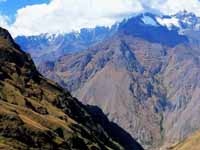
The Inca Trail
The world-famous Inca Trail is the toast of South America's hikes. Constructed as a royal road to the citadel of Machu Picchu, the stone-paved walk ventures deep into cloud forests…
The Inca Trail
The world-famous Inca Trail is the toast of South America's hikes. Constructed as a royal road to the citadel of Machu Picchu, the stone-paved walk ventures deep into cloud forests and provides dramatic climbs up the mountains. The beautiful but arduous four-day trail is part of the Machu Picchu Historic Sanctuary. Hikers cross over three high-altitude mountain passes and come across scattered Inca ruins, with exotic vegetation and awe-inspiring views being constant companions. The ancient royal route reaches the stone Sun Gate, from where Machu Picchu becomes visible and Huayna Picchu's looming peak dominates the background. Visitors must arrange hikes through an official Inca Trail agency as independent trekking is prohibited, with permits ideally booked long in advance.
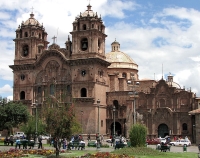
Plaza de Armas
The Plaza de Armas is Cuzco's graceful main square, lined with colonial-style covered walkways and houses containing souvenir shops. Visitors will also find bars, restaurants and t…
Plaza de Armas
The Plaza de Armas is Cuzco's graceful main square, lined with colonial-style covered walkways and houses containing souvenir shops. Visitors will also find bars, restaurants and travel agencies, while a large cathedral overlooks the square. Its elaborately carved wooden altar is covered in gold and silver plate, and its carved wooden choir stalls are regarded as Peru's finest. Cathedral visitors usually linger over The Last Supper painting, where the table has a platter of the local Inca delicacy of roasted guinea pig. One of Cuzco's most ornately decorated churches, La Compania is also on the plaza. History lovers should make a point of walking the alleyway of Loreta, as it's lined with Incan stone walls.
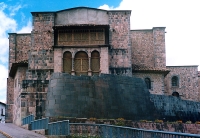
Coricancha Inca Ruins
The sacred complex of Coricancha was considered the centre of the Inca world, with the walls and floors of the Temple of the Sun once covered in sheets of solid gold and accompanie…
Coricancha Inca Ruins
The sacred complex of Coricancha was considered the centre of the Inca world, with the walls and floors of the Temple of the Sun once covered in sheets of solid gold and accompanied by golden statues. But Spanish colonists constructed the Church of Santo Domingo on the site, destroying the temple and using its foundations for the cathedral. Major earthquakes have severely damaged the church, though the stone walls still stand and bear testament to their sophisticated masonry. Visitors will find an underground archaeological site museum nearby, containing a number of interesting pieces such as mummies, textiles and sacred idols.
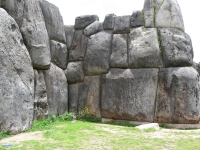
Sacsayhuaman
Of the four ruins near Cuzco, Sacsayhuaman is the closest and most remarkable. Spanish conquistadors used it as a quarry during their day, providing many of the materials for the c…
Sacsayhuaman
Of the four ruins near Cuzco, Sacsayhuaman is the closest and most remarkable. Spanish conquistadors used it as a quarry during their day, providing many of the materials for the city's colonial buildings. It's often referred to as a fortress because of its high, impenetrable walls but some believe it to be a religious or ceremonial centre. According to estimates, the complex took about 100 years to build, requiring thousands of labourers. The massive blocks of stone fit together perfectly, each weighing between 90 and 125 tonnes, and standing around 16ft (5m) tall. History buffs will note that the Inca and Spanish fought at the centre during the infamously bloody battle of 1536. Today, the site holds the annual celebrations of Cuzco's most important festival, the colourful Inti Raymi.
Transport
A steep 40 minute (2km) walk up from the Plaza de Armas.
The Sacred Valley (Urubamba River Valley)
Known as the Sacred Valley of the Incas, this breathtakingly beautiful and fertile valley stretches between the villages of Pisac and Ollantaytambo. Travellers will navigate it on …
The Sacred Valley (Urubamba River Valley)
Known as the Sacred Valley of the Incas, this breathtakingly beautiful and fertile valley stretches between the villages of Pisac and Ollantaytambo. Travellers will navigate it on the winding Urubamba River, with ancient Inca ruins watching from the hilltops above. Agricultural terraces flank the steep sides of a mountain crowned by alarmingly narrow trails, all leading to the cliff-hugging citadel above Pisac with massive stone doorways and stairways cut into rock. The temple-fortress of ancient Ollantaytambo also sits on the cliff edge. Originally developed as an Inca administrative centre, its layout is one of the few remaining models of an Inca grid plan. The ruins include the Royal Chamber, the Princess Baths and the Temple of the Sun.
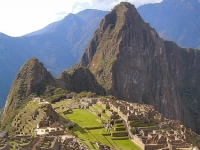
Machu Picchu
The ancient Inca citadel of Machu Picchu is regarded as the most significant archaeological site in South America, perched high in the Andes. Fortunately, Spanish colonists didn't …
Machu Picchu
The ancient Inca citadel of Machu Picchu is regarded as the most significant archaeological site in South America, perched high in the Andes. Fortunately, Spanish colonists didn't discover and destroy the structure, as it's completely concealed from below. The site is surrounded by grazing llamas and steep agricultural terraces, and consists of a central plaza, towers, palaces and water canals, as well as ornate fountains and a sacred ceremonial area of royal tombs and intricately carved temples. The sacred Temple of the Sun is one of the site's highlights, with the mountain of Huayna Picchu forming a dramatic backdrop to the city.
Website www.machupicchu.gob.pe
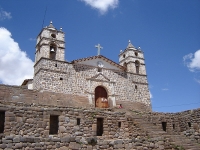
Ayacucho
Located in Peru's central highlands and crossed by two mountain ranges, Ayacucho is home to some of the country's most significant archaeological attractions, as well as gorgeous, …
Ayacucho
Located in Peru's central highlands and crossed by two mountain ranges, Ayacucho is home to some of the country's most significant archaeological attractions, as well as gorgeous, pastel-coloured colonial buildings. An ancient capital city, some of the oldest prehistoric remains found in America and richly decorated churches are all part of the destination's inheritance. Ayacucho is a relatively unknown tourism gem due largely to previous political unrest. Fortunately, travellers are rediscovering it, with the best time to visit around Easter when the city's carnival celebrations are in full swing.



